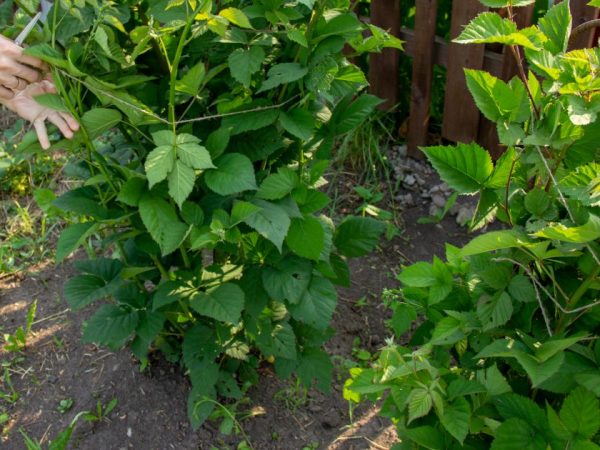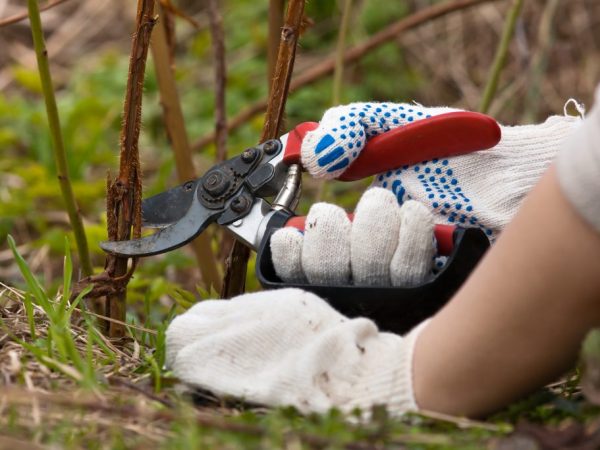Caring for remontant raspberries - essential autumn procedures
Caring for remontant raspberries has a number of features. From the correctly carried out measures in the fall, it directly depends on how the plant will endure frosts, and how productive it will be in the next season.

Caring for remontant raspberries - essential autumn procedures
Feature of remontant species
The name comes from the French word, which means "fruitful repeatedly".
Repaired varieties are capable of producing berries not only from last year's two-year-old shoots, but also from new, one-year ones, i.e. twice a season - in summer and autumn.
If summer raspberry bushes can be trimmed after picking berries, then you should not rush to trim these varieties. The timing of preparation for winter is noticeably shifting. new shoots will still be able to harvest the autumn harvest.
Basic rules of care
In the fall, it is necessary to reduce the amount of watering and fertilization before winter - this will increase the immunity of the bush and help withstand frost.
Watering
Since October, a pre-winter regime is gradually introduced for the raspberry bush and watered not as often as in summer, reducing the volume of water by 2-3 times.
The basic rule is to moisten the soil layers to a depth of at least 0.4 m.
Top dressing
Autumn nutrition does not consist in enhancing growth, but in maintaining a plant weakened by fruiting before winter.
At the end of the growing season, fertilizers are applied, which contain phosphorus and potassium, but little nitrogen.
It is better to use nitrogen-containing complexes in the spring. They are avoided before winter so as not to activate the build-up of green mass.
The basic rule is to apply top dressing after watering and after pruning.
The norm for potassium, superphosphate mineral compositions is 1 tsp each. per shrub.
Additionally, the soil is fertilized with humus, 10 liters per plant. When growing raspberries on sandstones, the amount of nutrients can be doubled.
Preparing for winter
Before the onset of cold weather, the raspberry bush is tied up and covered, protecting it from frost.
Tying bushes
Bending and tying branches begins when there is no foliage left on the bush. In this case, the garter should be completed by the time the first autumn frosts are approaching.
Failure to comply with these terms can adversely affect the state of the shoots when they bend with subsequent freezing.
Some gardeners prefer to collect branches in a bunch, however, as practice shows, such preparation for winter rarely ends with success.
The best way to protect the bush from frost is to bend and tie at the same time. The optimal tilt distance is up to 0.5 m. In this case, all shoots should go in the same direction, they are fixed with a wire (additionally, they use arcs and pegs).
Shelter for the winter

It is necessary to bend the whole bush in one direction
Most varieties of remontant raspberries need shelter for the winter - they do this immediately after pruning. The covering material can be snow cover and leaf litter mixed with coniferous spruce branches, the layer of which should exceed 0.2-0.3 m.
The Yellow Giant variety copes with the winter temperature drop without additional insulation.
When planting and growing fruit and berry crops in the open field in northern areas, where severe frosts are often observed, they resort to foam plastic, roofing material, cardboard, geotextile and film shelter.
The main condition for nonwoven covering materials is air permeability, therefore, in dense artificial coatings, it is required to make holes for oxygen to enter.
Moisture retention
To retain moisture, a supporting structure is created so that the precipitation that falls upon the onset of heat gives the shrub as much useful melt water as possible.
Snow retention also acts as an additional measure to protect raspberries from frost. For these purposes, a trellis is placed from the leeward direction, shields are installed and, with the beginning of an active snowfall, snow is thrown.
Mulch also retains moisture well in the soil. Straw and cut grass, laid out in a layer of about 5-7 cm around the bush, will additionally warm the roots in winter.
You should not mulch raspberries with sawdust, because this is a favorable environment for the development of fungi, and in the process of debate they release a fairly large amount of nitrogen, which is not particularly useful for the plant in winter.
Autumn pruning
Often, by the fall, raspberry repair varieties grow and give development to a large number of roots. It becomes possible to cut the bush and plant fresh shoots from the mother plant.
Dates of the
These raspberry varieties begin to be pruned in September-October, after the fruiting period. Only in the northern regions, pre-winter, the formation of a bush sometimes occurs at the end of August.
Residents of the southern regions should not rush to pruning. Warm weather that lingers in autumn can cause fresh shoots to appear and buds to awaken.
When the gardener plans to harvest only one crop from a remontant bush for the next season, you can shift these dates and cut the raspberries at the end of October, until the beginning of December.
Scheme
The raspberry bush is cut according to a certain pattern:
- first, the upper part of the annual shoots is shortened;
- then they begin to remove the two-year-old branches that have bore fruit;
- at the last stage, they get rid of weak and mechanically damaged shoots that are not able to survive the winter cold.
In newly planted shrubs, the procedure is limited to shortening the branches to a length of 0.2 m. Full pruning will be shown to them and will be useful only for the next spring season.

Full pruning helps increase yields
If you intend to reduce the yield to one per year, you can shorten the branches to the level of the soil surface, leaving shoots 5-7 cm long.
New shoots will sprout from the roots by spring, which will give berries in September. Such a cardinal procedure is especially important for a plant older than 3 years from the moment of planting, because when this age is reached, his fruits begin to shrink. The complete removal of shoots helps to rejuvenate the fruit and berry culture.
Treatments for pests and diseases
Caring for remontant raspberries in the fall also involves treatments against pests and pathogens that hide in vegetative frequent shrubs, maintaining their vital activity throughout the winter, and in the spring when warm comes, they are activated.
After harvesting the berries, the bush is sprayed with fungicides.
Commonly used ones include:
- Fufanon - 1.5 liters for each plant;
- Actellik - 1.5 liters per 10 m².
When activated near moss and lichen shrubs, the soil is treated with iron sulfate.
To prevent the raspberry bush from becoming an object of attack by rodents, gardeners wrap the trunks and the lower tier of branches with burlap, and they install metal mesh fences around the raspberries.
Summing up
If you properly care for raspberries in the fall and create protection from frost, the fruit and berry culture will bring a good harvest in the next season, and timely pruning will provide a large number of berries.

